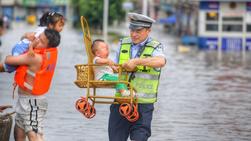 Police officers evacuate children stranded in floodwaters in Hefei, Anhui province, on July 20, 2020. (ZHANG HONGFEI / FOR CHINA DAILY)
Police officers evacuate children stranded in floodwaters in Hefei, Anhui province, on July 20, 2020. (ZHANG HONGFEI / FOR CHINA DAILY)
Despite southern China being soaked in the past two months by the second-highest amount of precipitation since 1961, the country has experienced a vast decrease in the number of fatalities in floods so far this rainy season thanks to the government's efforts in ramping up flood mitigation, an emergency official said.
From July 1, the start of the country's primary rainy season, to July 28, over 54.8 million people suffered floods, up by 23.4 percent from the average of the same periods in the past five years, according to the Ministry of Emergency Management.
The number of people left dead or missing due to floods dropped by 53.9% to 158 this rainy season, thanks to the government's efforts in ramping up flood mitigation, according to the Ministry of Emergency Management
The number of people evacuated during the period reached almost 3.8 million, an increase of 36.7 percent from the average between 2015 and 2019, it added.
Meanwhile, the number of fatalities and the rooms demolished fell sharply from the past five years' average. While the number of people left dead or missing dropped by 53.9 percent to 158, only 41,000 rooms were demolished by floods, down 68.4 percent, the ministry said.
The numbers show that the government's efforts to enhance flood control is paying off as the country continues to battle severe, wide-ranging floods this year, said Yang Xiaodong, deputy director-general of the ministry's disaster relief and material logistics department.
ALSO READ: Water projects stand test of strongest floods in 20 years
While holding daily consultations to coordinate flood mitigation efforts in different regions, the ministry has dispatched dozens of work teams to guide local governments in their work, he noted.
Adhering to the notion that "people's interests should be put first, and nothing is more precious than people's lives", the national comprehensive rescue teams with the ministry, together with grassroots officials, soldiers and militia members, saved and transferred a large number of people threatened by floods, he said.
"This has effectively reduced the number of people left missing or dead," he continued.
According to the ministry, as of July 31, national rescue teams have participated in flood control and rescue efforts 11,242 times.
The more than 140,000 rescuers who have been mobilized have saved 38,077 people in danger and evacuated another 109,000.
Yang said the decrease in the number of rooms demolished by floods show that the anti-disaster capability of people's houses has been greatly enhanced as governments of different levels pay increasingly greater attention to infrastructure construction.
The declines of fatalities and demolished rooms occurred as the second-highest amount of precipitation in nearly six decades fell in southern parts of the country from June 1 to July 28.
During that period, southern parts of the country on average received 436 millimeters of precipitation, 18 percent more than normal and the second highest since 1961, according to the National Climate Center.
READ MORE: Risk of major flooding increases in Huaihe River
"After entering plum rain season, the southern regions were frequented by rainstorms. …Many areas experienced record-high precipitation," the center said.
The season refers to a long period of continuous rainy or cloudy weather that often occurs in June and July as plums ripen in regions around the middle and lower reaches of the Yangtze River.
The two reaches of the Yangtze, for example, were battered by an all-time high precipitation of 617 millimeters from June 1 to July 28, 65 percent more than usual, it said.
It said the largest daily precipitation so far this rainy season occurred in Yangshuo county, Guangxi Zhuang autonomous region, with 327 millimeters, or about 60 percent of the annual average precipitation in Beijing.


